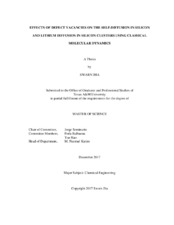| dc.description.abstract | With the recent advances in micro-electronics and exponential rise in demand for electronic devices and their miniaturization, it is of utmost importance that self-diffusion phenomena in silicon be well understood. However, self-diffusion of silicon clusters with fraction vacancies is still not well understood as is evident from the fact that the reported values of activation enthalpy of self-diffusion via vacancies range from 3.6 to 4.9 eV, for various experiments carried out in the same temperature range of 650 degrees C to 1388 degrees C, which indicates how imprecise the existing measured values are for the same temperature range. This work overcomes the experimental limitation using molecular dynamics to calculate the self-diffusion coefficients both at room temperature and temperature above the melting point. Silicon clusters of the same spherical geometry and size with varying fraction vacancy have been studied using molecular dynamics and Tersoff potential to estimate phase changes and diffusion coefficients.
At 300 K, the self-diffusion coefficient values vary non-monotonically, i.e. at 7.5 % fraction vacancy the value of self-diffusion coefficient falls to half of its value at 0 % fraction vacancy while it increases by two orders of magnitude at 20 % fraction vacancy. At 2000 K, however, there is only a marginal monotonic increase with gradually varying fraction vacancy. It is found that as fraction vacancy increases, the diffusion coefficient value of lithium in silicon shows non-monotonic behavior for the same number of Li atoms in silicon nanosphere which is an important result in a sense that the behavior of the variation of dopant diffusion with respect to vacancies is directly found in this work. This work thus furthers the understanding on vacancy mediated self-diffusion which can lead to better diffusion control essential to device miniaturization. It also provides information on the dependence of the temperature, energy, pressure and phase changes of the silicon clusters with varying fraction vacancy which can be critical as a guideline for material design and selection for thermoelectric, optoelectronic devices and thermal transducers.
It was also found that charge equilibration, applied to small nanocluster system, gave more precise value of the diffusion coefficient. | en |


